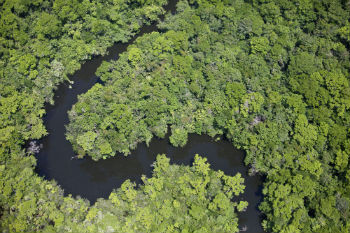Main menu
CEPF is a joint initiative of l’Agence Française de Développement, Conservation International, the European Union, Fondation Hans Wilsdorf, the Global Environment Facility, the Government of Japan and the World Bank.
Visitez le site français コア情報の日本語翻訳を読むOr use Google Translate to translate the English site to your language:
GTranslate
Developing Ecotourism in a Post-Conflict Country
How one CEPF grantee is establishing birding trails in Colombia
By: Marsea Nelson, CEPF senior communications manager
22 March 2018
22 March 2018
CEPF Grantee:
Asociación para el Estudio y Conservación de las Aves Acuáticas en Colombia
Project Title:
Planning the Paraguas - Munchique Conservation Corridor Birding Trail in Colombia - Phase I
Grant Amount:
US$74746.30
Biodiversity Hotspot:
Tropical Andes
This article is also available in Spanish. (PDF - 430 KB)
Colombia has the greatest diversity of birds of any country in the world, but its potential as a premiere destination for birdwatching is largely untapped.
Calidris Association, a Colombian nonprofit organization that focuses on bird conservation, is working to develop that potential by creating birding trails with the help and input of local communities. These communities will benefit economically from the tourism by supplying guides, restaurants, hotels and transportation. Calidris works jointly with the National Audubon Society, their U.S. partner, to develop these trails.
In phase one of the project, funded by CEPF, Calidris laid the groundwork for the Western Andes Birding Trail, which includes birding sites in the Paraguas-Munchique Conservation Corridor.
Among project activities were site selection for the trail, community outreach, the establishment of local alliances, and the creation of marketing and implementation strategies.
Challenge: Shifting political climate
The 2016 Colombian peace accord with the Revolutionary Armed Forces of Colombia (FARC) offers a promising beginning to the end of the country’s armed conflict but, according to Kendra Hasenick, project coordinator, the FARC’s exit from many areas has created “a redistribution of power, which brings up new security issues.” The success of the project depends on tourism, so the political climate is a crucial consideration.
Solution: Careful planning
Hasenick acknowledged that, ultimately, the political situation is beyond their control, but when Calidris considered which sites to include on the birding trail, safety was an important factor. The sites they prioritized during the planning phase are close to major cities that are known to be safe. This proximity also gives international tourists easier access to the trails and tourism services.
Challenge: Strengthening relationships with communities
Though Calidris had previously worked with the majority of the communities on the future Western Andes Birding Trail, they had not worked with them on bird tourism specifically.
Solution: Work with partners and establish trust
Calidris reached out to local environmental and community organizations to connect with community members interested in the initiative and to thoroughly understand the community’s needs and qualities.
These local partners had well-established relationships and could give Calidris crucial background information and help build trust.
As part of the process to decide if a site would be good to include on the trail, Calidris held initial meetings with community members to discuss what bird tourism is as well as its potential.
“We gave people the opportunity to express their opinions and fears and express their doubts and discuss what the project would mean for the area and for the people,” Hasenick said. “We had one community that had incredible birding, but the community said they weren’t ready [for tourism]. It was really wonderful to have that conversation.” Calidris respected the community’s wishes and did not develop the birding site.
Challenge: Managing expectations
Bird tourism has been developed on many different levels in the region. While Hasenick said this is wonderful, it means that in some communities there are already expectations of what birding tourism is and what that means for their communities.
“We don’t want to ignore what people have already done in terms of ecotourism and conservation, and it’s important to collaborate with what local organizations are already doing, but it can be challenging because there are many different ideas,” Hasenick said.
Solution: Open, clear communication
“It’s important to acknowledge, appreciate and strengthen what is already in a local community instead of covering it up with your own work because, at the end of the project, the implementation team leaves, but the community stays,” Hasenick said.
There were, however, limits to what Calidris could offer. Through clear, matter-of-fact presentations explaining the goals and capacity of the project, Hasenick said that conversations with community members about what Calidris could and could not do were rarely uncomfortable.
Challenge: Promote the trail to an international audience
An important component of the project was to develop a marketing plan that would help bring international tourists to Colombia and the Western Andes Birding Trail. Calidris is experienced with bird research and environmental education, but their team has little marketing know-how.
Solution: Identify what makes the Western Andes Birding Trail distinct
Developing a marketing strategy for the trail proved complex. Hasenick said it was difficult to find an ideal marketing consultant because what Calidris was promoting—Colombia tourism emphasizing birdwatching and local communities—was so niche. “It showed us how disconnected the market is from the product,” she said.
Working with a marketing consultant helped the Calidris team in understanding the marketing process and in recognizing each site’s distinctive features and the uniqueness of the Western Andes Birding Trail as a whole. These attributes will help focus the marketing strategy going forward.
Looking Forward
Colombia’s regional and national governments have become interested in supporting the development of the birding trails. Calidris is currently waiting for the endorsement of private and public donors before breaking ground on the trail. The organization and its partner Audubon have organized future funds to cover community professional development and tourism preparation, promotion and conservation.









